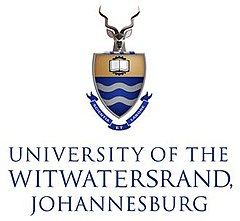Faculty of Humanities (University of the Witwatersrand)
 |
|
|
Former names
|
South African School of Mines (1896–1904), Transvaal Technical Institute (1904–1906), Transvaal University College (1906–1910), South African School of Mines and Technology (1910–1920), University College, Johannesburg (1920–1922) |
|---|---|
| Motto | Scientia et Labore (Latin) |
|
Motto in English
|
Knowledge and work |
| Type | Public university |
| Established | 1922 |
| Affiliation | AAU, ACU, FOTIM, HESA, IAU |
| Chancellor | Deputy Chief Justice Dikgang Moseneke |
| Vice-Chancellor | Professor Adam Habib |
| Chairman of Council | Dr. Randall Carolissen |
|
Academic staff
|
4,712 |
|
Administrative staff
|
6,585 |
| Students | 33,711 |
| Undergraduates | 21,890 |
| Postgraduates | 11,821 |
| 1,808 | |
| Location |
Johannesburg, Gauteng, South Africa 26°11′27″S 28°1′49″E / 26.19083°S 28.03028°ECoordinates: 26°11′27″S 28°1′49″E / 26.19083°S 28.03028°E |
| Campus | 2 urban and 3 suburban campuses |
| Colours | Blue and gold |
| Nickname | Wits |
| Mascot | Kudos Kudu |
| Website | www |
The University of the Witwatersrand, Johannesburg, is a multi-campus South African public research university situated in the northern areas of central Johannesburg. It is more commonly known as Wits University or Wits (English: /vɪts/ or /vʌts/). The university has its roots in the mining industry, as do Johannesburg and the Witwatersrand in general. Founded in 1896 as the South African School of Mines in Kimberley, it is the third oldest South African university in continuous operation, after the University of Cape Town (founded in 1829), and Stellenbosch University (founded in 1866).
In 1959, the Extension of University Education Act forced restricted registrations of black students for most of the apartheid era; despite this, several notable black leaders graduated from the university. It was desegregated once again prior to the abolition of apartheid in 1990. Several of apartheid's most provocative critics, of either European or African descent, were one-time students and graduates of the university.
The university has an enrolment of 33,711 students as of 2015, of which approximately 18 percent live on campus in the university's 22 residences. 65 percent of the university's total enrolment is for undergraduate study, with the remaining 35 percent being postgraduate.
...
Wikipedia
